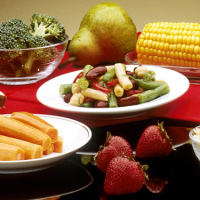Facts About Fiber You Probably Didn’t Know
Fiber is a type of carbohydrate that the body cannot digest, yet it plays a critical role in maintaining overall health. Unlike other carbohydrates such as sugars and starches, fiber passes through the digestive system mostly intact. Its presence promotes optimal functioning of the gastrointestinal tract and offers a range of health benefits, including better digestion, reduced cholesterol levels, and controlled blood sugar levels.
Dietary fiber comes in two primary forms: soluble fiber and insoluble fiber. Both types are essential for maintaining health, but they have distinct roles within the body.
Types of Fiber and Their Functions
Soluble Fiber
Soluble fiber dissolves in water, forming a gel-like substance in the stomach. This type of fiber is particularly effective at lowering cholesterol levels by binding with bile acids and removing them from the body. It also helps regulate blood sugar levels by slowing the absorption of glucose. Foods rich in soluble fiber include:
- Oats
- Barley
- Apples
- Citrus fruits
- Beans
- Lentils
Insoluble Fiber
Insoluble fiber does not dissolve in water and adds bulk to stool, facilitating its passage through the digestive tract. This type of fiber prevents constipation and promotes bowel regularity. It also aids in maintaining a healthy gut microbiome. Foods high in insoluble fiber include:
- Whole grains
- Nuts
- Seeds
- Vegetables such as broccoli, cauliflower, and carrots
Health Benefits of Fiber
1. Promotes Digestive Health
Fiber supports digestive health by ensuring regular bowel movements and preventing constipation. Insoluble fiber works as a natural laxative, while soluble fiber feeds beneficial gut bacteria, fostering a balanced gut microbiome. This, in turn, reduces the risk of digestive disorders like irritable bowel syndrome (IBS) and diverticulitis.
2. Reduces Cholesterol Levels
Soluble fiber binds with cholesterol molecules in the digestive system, preventing their absorption into the bloodstream. This process helps lower levels of LDL (low-density lipoprotein), also known as “bad” cholesterol, reducing the risk of heart disease.
3. Regulates Blood Sugar Levels
For individuals managing diabetes or prediabetes, fiber plays a crucial role in stabilizing blood sugar levels. Soluble fiber slows the absorption of sugar, preventing blood sugar spikes after meals.
4. Supports Weight Management
High-fiber foods are often low in calories and help you feel full for longer periods. By promoting satiety, fiber reduces overall calorie intake, making it an essential nutrient for weight management.
5. Lowers the Risk of Chronic Diseases
A diet high in fiber has been linked to a reduced risk of several chronic diseases, including:
- Heart disease: Fiber helps maintain healthy blood pressure and reduces inflammation.
- Type 2 diabetes: Regular fiber intake improves insulin sensitivity.
- Colorectal cancer: Insoluble fiber promotes healthy bowel movements, reducing the risk of colon cancer.
How Much Fiber Do You Need?
The recommended daily intake of fiber varies by age and gender. According to dietary guidelines:
- Men under 50 years: 38 grams per day
- Men over 50 years: 30 grams per day
- Women under 50 years: 25 grams per day
- Women over 50 years: 21 grams per day
Unfortunately, most people fall short of these recommendations, consuming an average of only 15 grams per day.
Best Sources of Dietary Fiber
Including fiber-rich foods in your diet is crucial for meeting daily requirements. Below are some of the best sources:
Whole Grains
Whole grains such as quinoa, brown rice, and whole wheat bread are excellent sources of fiber. They also provide essential nutrients like B vitamins, iron, and magnesium.
Fruits
Fruits like apples, pears, bananas, and berries are rich in both soluble and insoluble fiber. Consuming whole fruits is preferable to drinking fruit juices, as the latter often lacks fiber.
Vegetables
Leafy greens, carrots, and root vegetables are fiber powerhouses. Consuming a variety of vegetables ensures a good balance of fiber types.
Legumes
Beans, lentils, and chickpeas are among the richest sources of dietary fiber. They are also packed with protein, making them ideal for vegetarians and vegans.
Nuts and Seeds
Almonds, chia seeds, and flaxseeds are excellent sources of fiber. These foods are also rich in healthy fats, which support heart health.
Tips to Increase Fiber Intake
- Start Your Day with Fiber-Rich Foods: Opt for whole-grain cereals or oatmeal topped with fresh fruits.
- Snack Smartly: Replace processed snacks with high-fiber options like nuts, seeds, or raw vegetables.
- Include Legumes in Meals: Add beans or lentils to soups, salads, or stews for a fiber boost.
- Choose Whole Grains: Replace white rice, bread, and pasta with whole-grain alternatives.
- Stay Hydrated: Drinking plenty of water is essential when increasing fiber intake to prevent digestive discomfort.
Potential Side Effects of Too Much Fiber
While fiber is essential for health, consuming too much too quickly can lead to side effects such as:
- Bloating and Gas: Sudden increases in fiber intake may disrupt gut bacteria balance.
- Constipation or Diarrhea: Without adequate hydration, excessive fiber can cause digestive issues.
To avoid these side effects, increase your fiber intake gradually and pair it with sufficient water consumption.
Conclusion
Fiber is a vital nutrient that offers numerous health benefits, from improved digestion to reduced risk of chronic diseases. Incorporating a variety of fiber-rich foods into your diet ensures optimal health and well-being. By prioritizing whole grains, fruits, vegetables, legumes, and nuts, you can easily meet your daily fiber requirements.










